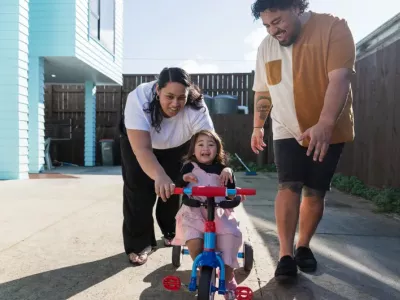Game over or game on? Screen time and kids’ mental health

“Kids don’t need screens – their parents should just throw them away!”
Has anyone ever said anything like this to you? Have you thought something like this yourself?
Parenting in the digital age is a daily challenge we may not always feel prepared for. Unless you’ve decided to live off the grid, digital devices are part of the fabric of our children's world. Add to this that everyone from the media to our neighbours and friends seems to have an opinion on the amount of screen time kids should have. These views vary widely and don’t tend to be positive, leaving screens with a bad reputation.
There is logic to being careful with our kids’ and devices though, as excessive screen time has been linked to physical and mental health problems in children and adolescents.1,2 Not to mention the online safety risks that can come with using screens, as well as concerns like cyberbullying on social media.
The challenge is, it is usually not as simple as ‘throwing’ screens away. Going without screens can work very well for some families, but it is not an option for many. Devices are often used in schools as an educational tool and phones can be needed for communication. We use them in our homes, of course, for work or personal reasons. So, children are surrounded by them. But, if we manage to create balanced electronic device use in our homes, it can have positive outcomes for our children’s education and social connection. They can also be just plain fun among all the stresses of life.2 That doesn’t mean there shouldn’t be limits, especially for young children.
Screen stress and guilt can be common for parents
Based on last year’s Triple P Parenting Survey, we know that many parents and carers are worried about their children’s screen use and want more guidance on managing this. It’s common to feel guilty for allowing our children to use screens, yet this guilt isn’t great for their development either, as it can cause us to feel more stressed and impact our relationship with them.3 Weighing up if children should be on screens or not and for how long can make us feel stressed about what action to take. Sometimes, this can also cause conflict with our kids about their use, leading to potentially even more feelings of guilt.
So, what can we do if we can’t simply throw their screens away?
Quality over quantity might be the answer.
Reframing screen time as quality over quantity
One way to view screens is not so much as being ‘good’ or ‘bad’ or looking at them as a ‘reward’ or ‘punishment’, but rather as a part of life that we should try to use appropriately and balance with other areas, like physical activity.
An approach to this may be reframing screens to think about what our kids are using screens for, rather than focusing on the time spent on them. In other words, it could be about quality over quantity. For example, while too much time on screens has been negatively associated with lower child language levels, better quality screen use – like educational programs and co-viewing with caregivers – has been positively associated with child language skills.4
Ideas for ‘quality’ screen time: from social media to video games
There is no one-size-fits-all approach when it comes to kids and screen use for social media, video games, apps or watching television. A teenager might have different limits to that of a primary school child, for example. There are also circumstances where children, including some with disability or additional needs, may use screens to help self-regulate, for sensory reasons, or to communicate, so their screen use may need a different approach.5
What do you think might work in your household?
It can be helpful to monitor your child’s use and – depending on children’s ages and needs –create boundaries that help keep them safe and suit your family. You decide what you are comfortable with, but to get you started, here are some ideas you could try.
Screen time tips for young children (up to age 5)
- According to most international health guidelines, experts recommend no screens for children under two years old, but this doesn’t always include video calls. Children chatting or being seen on video calls to family and friends is quality use of screens as it is a lovely way to build and maintain connections.6
- From ages 2-5, no more than one hour of recreational screen use is typically recommended. To get the most out of this time, try educational programs and games. Watching, playing and talking about these games or programs with your kids can also be a great way to bond with them.
- Role modelling positive screen use from an early age can also make a difference. Children pick-up on what you do, even as babies. They notice our habits and how much time we spend in front of a screen. Parents who have higher rates of screen use tend to have children who also have higher rates of screen use.7
Screen time tips for school-aged children (5-16)
- Most international guidelines suggest limiting screen time to two hours a day, not usually including time needed for school work.7 To help make this more ‘quality’ time, try taking an interest and monitoring what they are doing. This is partly for safety reasons as well and an opportunity to connect with your child. When parents monitor screen use, it can lead to them using screens less and reduce inappropriate use.1 This could look like asking about the video games they are playing, and perhaps even playing these with them. You could also monitor what apps they download and take notice of who they talk to or what they do online.
- Use parental controls: The risk with screens is often more about what kids are doing or seeing on them than how long they are using them for – and sometimes we need to step-in to control this. Look into what controls you can set on the television, apps or games. Regularly check that these are still on, as kids can often figure out how to turn them off.
- Create boundaries. Schedules and limits for screen use are important for children, as these can reduce problematic use and lower screen time overall.1 This can be particularly important during times like school holidays. Depending on their age, you could work with your child on this, such as if they will have their device time before or after school. Keep in mind that not all screen time is created equal. There is a difference between hours on a video game and online messaging with a friend, for example, which may be helpful for good mental health. Some flexibility could also be okay as kids get older. Showing your children how to follow a screen-time schedule can be very helpful, for them, and for you.
- Planning other activities to swap out for screen use can also help keep kids off screens for a bit longer, like going to the park after school, or enrolling them in a sport or activity.
- Have open conversations: The risks of cyberbullying, identity theft and online harm are real. But if we build a strong, healthy connection with our children by showing interest in what they have to say, we can build a strong bond. When we have this bond, it puts us in a better position to support them if they need help or things do go wrong online.
- Cyberbullying can become an issue during school years. Building on open conversations being important, talk to your child about online bullying and let them know they won’t get in trouble for coming to you if they have any concerns. Encourage positive relationships with peers and try to help them nurture these.
With these tips at hand, you may have a few more options to consider when it comes to screens, so that it doesn’t have to just be ‘game over’ for all devices. For more ideas on creating boundaries for screen use, you might like to check-out our range of online parenting programs. For families of children aged 12 and under, Triple P Online can help. For support with teens, you could try Teen Triple P Online. For parents and carers of children with disability, you might be interested in Stepping Stones Triple P Online.
For more tips and strategies for raising confident kids, visit Triple P Online.
References
- Nagata, J. M., Paul, A., Yen, F., Smith-Russack, Z., Shao, I. Y., Al-Shoaibi, A. A., ... & Baker, F. C. (2024). Associations between media parenting practices and early adolescent screen use. Pediatric Research, 1-8. https://doi.org/10.1038/s41390-024-03243-y
- Muppalla, S. K., Vuppalapati, S., Pulliahgaru, A. R., & Sreenivasulu, H. (2023). Effects of excessive screen time on child development: An updated review and strategies for management. Cureus, 15(6). https://doi.org/10.7759/cureus.40608
- Wolfers, L. N., Nabi, R. L., & Walter, N. (2024). Too much screen time or too much guilt? How child screen time and parental screen guilt affect parental stress and relationship satisfaction. Media Psychology, 1-32. https://doi.org/10.1080/15213269.2024.2310839
- Madigan, S., McArthur, B. A., Anhorn, C., Eirich, R., & Christakis, D. A. (2020). Associations between screen use and child language skills: A systematic review and meta-analysis. JAMA pediatrics, 174(7), 665-675. https://doi.org/10.1001/jamapediatrics.2020.0327
- Alper, M., Alcorn, A.M., Harrison, K., Manganello, J.A., Romeo, R.R. (2025). Digital Media and Neurodevelopmental Differences. In: Christakis, D.A., Hale, L. (eds) Handbook of Children and Screens. Springer, Cham. https://doi.org/10.1007/978-3-031-69362-5_8
- Swider-Cios, E., Vermeij, A., & Sitskoorn, M. M. (2023). Young children and screen-based media: The impact on cognitive and socioemotional development and the importance of parental mediation. Cognitive Development, 66, 101319. https://doi.org/10.1016/j.cogdev.2023.101319
- Cost, K. T., Unternaehrer, E., Tsujimoto, K., Vanderloo, L. L., Birken, C. S., Maguire, J. L., ... & Charach, A. (2023). Patterns of parent screen use, child screen time, and child socio‐emotional problems at 5 years. Journal of Neuroendocrinology, 35(7), e13246. https://doi.org/10.1111/jne.13246

